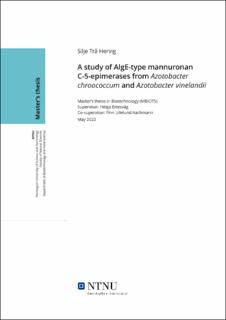| dc.description.abstract | Alginat er en biopolymer bestående av beta-D-mannuronsyre (M) og alfa-L-guluronsyre (G), bundet sammen med 1-4 glykosidbindinger. Alginat er biokompatibelt og kan danne hydrogeler, som for eksempel kan brukes i medisinsk sammenheng og i matindustrien. Polymeren består av G-blokker, M-blokker og MG-blokker av ulik lengde og hyppighet. Strukturen påvirker de fysiokjemiske egenskapene til alginatet. G-blokker kan for eksempel kobles sammen ved hjelp av kalsiumioner, som fører til geldannelse. Andelen G og lengden på G-blokkene er derfor viktige faktorer for egenskapene til alginat. Mannuronan C-5 epimeraser og alginat lyaser er enzymer som henholdsvis epimeriserer og kløyver alginat og er derfor interessante verktøy for modifisering av alginat.
I dette prosjektet ble AlgE-type mannuronan C-5-epimeraser studert. Hovedmålet ved denne studien var å oppnå en bedre forståelse for funksjonen til disse enzymene og hvordan aktiviteten deres kan endres. Hensikten med dette er i det store bildet å legge til rette for videre bruk av bakterielle epimeraser og lyaser for modifisering av industrielt alginat. NMR ble brukt for å studere epimeriseringsmønstrene for to mannuronan C-5-epimeraser (AcAlgE1 og AlgE1). Lyaseaktiviteten til to bifunksjonelle mannuronan C-5-epimeraser og alginat lyaser, AcAlgE2 og AcAlgE3, ble studert for å måle enzymkinetikk og salt-avhengighet. Effekten av kalsium ble også testet og sammenliknet for kalsiumbindende seter i A-modulene til AlgE6 og AlgE7. En kvantitativ metode for å måle epimerase-aktivitet ble utviklet og testet i denne sammenhengen. I tillegg ble det forsøkt å rense AcAlgE1-3 med C-terminale His-tagger.
Det ble observert at AcAlgE1 produserte en større andel G enn AlgE1, men kortere G-blokker. Både AcAlgE2 og AcAlgE3 var avhengige av kalsium og ble påvirket av konsentrasjonen av NaCl. I tillegg ble det vist at et kalsium-bindende sete fra AlgE7 ble påvirket av kalsium annerledes enn den samme aminosyresekvensen i AlgE6. Det ble også funnet at C-terminale His-tagger ikke kunne brukes til rensing av AcAlgE1-3 og at E. coli SHuffle T7 express var bedre enn E. coli RV308 for produksjon av disse enzymene. | |
| dc.description.abstract | Alginate is a biopolymer consisting of beta-D-mannuronic acid (M) and alpha-L-guluronic acid (G), linked by 1-4 glycosidic bonds. The polymer is biocompatible and has the ability to form hydrogels, which for instance makes it useful for medical applications and in the food industry. Structurally, alginate consist of G-blocks, M-blocks and MG-blocks of variable lengths and frequencies. The structure affects its physiochemical properties. G-blocks can for instance crosslink with calcium ions, leading to gelation. The G-content and the length of the G-blocks are therefore important factors for the properties of alginate. Mannuronan C-5-epimerases and alginate lyases are capable of epimerizing M residues to G and cleave the alginate, respectively. This alters the properties of the polymer, making these enzymes interesting tools for modification of alginate.
In this project, AlgE-type mannuronan C-5-epimerases from Azotobacter were studied. The main objective of the study was to improve the understanding of the function of these enzymes and how their activity can be altered. In a larger perspective, the aim is to open for further use of bacterial epimerases and lyases for modification of industrial alginate. The mode of action of two mannuronan C-5-epimerases, AcAlgE1 and AlgE1, was studied and compared by NMR. Two bifunctional mannuronan C-5-epimerases and alginate lyases, AcAlgE2 and AcAlgE3, were studied to measure kinetics and salt dependency of their lyase activity. The effect of calcium was tested and compared for calcium binding sites in the A-modules of AlgE6 and AlgE7. For this purpose, an optimized epimerase assay was developed and tested. Additionally, a C-terminal His-tag was tested for purification of AcAlgE1-3.
In this work, it was found that AcAlgE1 produce higher G-content than AlgE1, but shorter G-blocks. AcAlgE2 and AcAlgE3 were both dependent on calcium and the lyase activity was affected by the NaCl concentration. It was also demonstrated that the studied calcium binding site from AlgE7 had different calcium dependency than the same amino acid sequence in AlgE6. In addition, it was found that a C-terminal His-tag could not be used for purification of AcAlgE1-3 and that E. coli SHuffle T7 express was better than E. coli RV308 for production of these enzymes. | |
